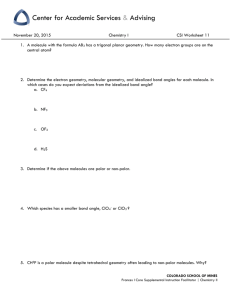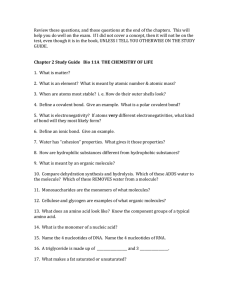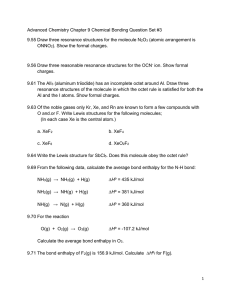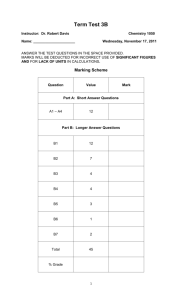1411 EXAM#3 (spring 2009).doc
advertisement
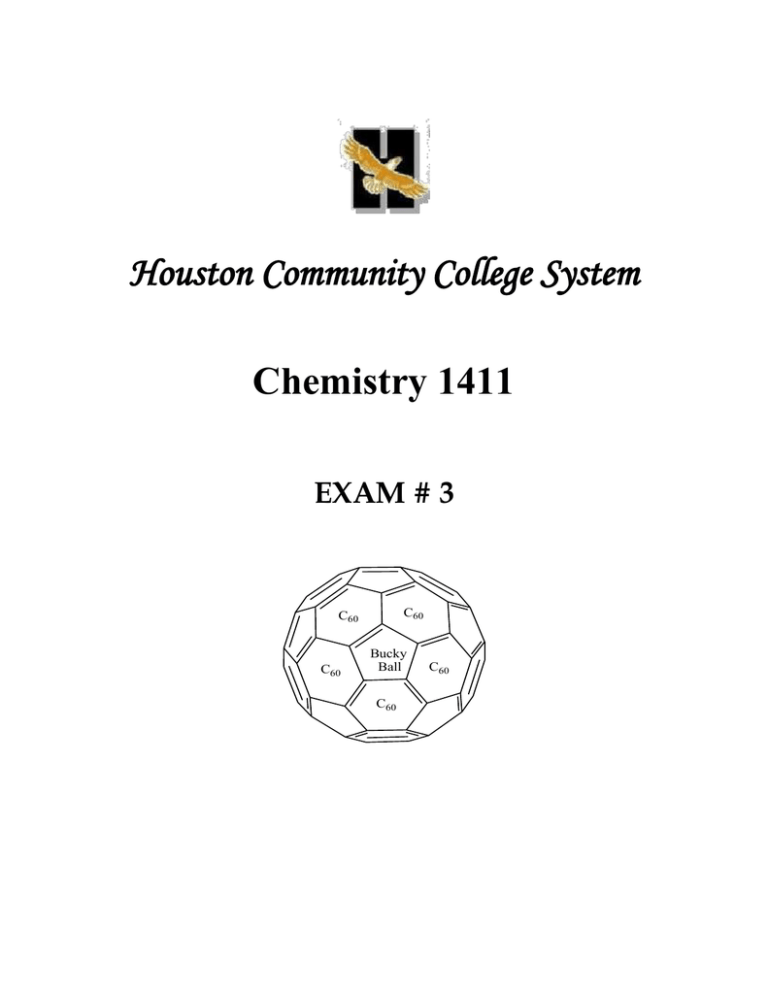
Houston Community College System Chemistry 1411 EXAM # 3 C60 C60 C60 Bucky Ball C60 C60 CHEM 1411 EXAM # 3 Spring 2009 Name: ________________________ Directions- please answer the following multiple-choice questions next to each number. Please show all your work for bonus question and part (2) questions in the space provided. Part (1) - Multiple Choice - (3 points each) _____ 1. Which of the following Lewis dot structures of N3¯ is written correctly? .. .. .. .. .. .. .. .. A. [N = N–N:] ¯ B.[N = N= N] ¯ C. [N =N N] ¯ D. [ N -NN] ¯ .. .. .. .. .. .. .. _____ 2. Which of the following molecules or ions has the most valence electrons. A. C2H6 B. SO3 C. BF4¯ D. SCl2 _____ 3. What is the formal charge of carbon in :CH3 ? A. 0 B. 1 C. +1 D. -1 _____ 4. Condensation is the reverse of which of these phase changes? A. melting B. Freezing C. Deposition D. Boiling ____ 5. What is the electron domain geometry of CBr4 ? A. trigonal bipyramidal B. linear C. trigonal planar D. tetrahedral _____6. For which of the following molecules is the electron domain geometry the same as the molecular geometry of the molecule? A. O3 B. IF5 C. NH3 D. SO42_____ 7. Which of the following is not true? A. The shape of carbon dioxide molecule is linear. B. When a metal reacts with a nonmetal a covalent bond is formed. C. A double bond occurs when two atoms share two pairs of electrons. D. A nonpolar covalent bond results from equal sharing of electrons between atoms in a molecule. _____ 8. Intermolecular forces include______ interactions. A. Dipole-dipole B. London dispersion C. Hydrogen bonding D. all of these _____ 9. In the Lewis structure for the following molecule, the molecule has ________ sigma and ___________pi bonds. CH3 O CH3 - CH - C - C A. 13 σ, 3 π N B. 4 σ, 13 π C. 13 σ, 4π 2 D. none of these _____ 10.The process of evaporation happens when which of the following occurs? A. A solid becomes a liquid B. A liquid becomes a solid C. A gas becomes a liquid D. A liquid becomes a gas _____ 11. What are the hybridization and angle of NF3? A. sp,120 0 B. sp3 , 109 0 C. sp2, 120 0 D. sp3,107 0 _____ 12. In drawing Lewis dot structures, the dots represent_______________ . A. protons B. valence electrons C. neutrons D. charges _____ 13. Which of the following molecules has a dipole moment? A. CS2 B. N2 C. O3 D. BeCl2 _____ 14. The bond between hydrogen and oxygen in the water molecule can be characterized as _________. A. dispersion forces B. hydrogen bonds C. London dispersion forces D. all of these _____ 15. Consider the molecule C2H2 . The hybridization of each carbon, C, is _______. A. sp3 B. sp2 D. dsp3 C. sp _____ 16. Which of the following has a bond order of 3? I. N2 II. O22- A. I only IV. CN- III. O2 B. I, IV C. III only D. II, III _____ 17.Which one of the following violates octet rule stability? A. Ca 2+ B. S2- C. Cl- D. Al2+ _____ 18. Which of the following cubic cells contains 3 atom? A. primitive cubic cell B. body-centered cubic cell C. face-centered cubic cell D. none of these _____ 19. Which of the following molecule is exception to octet rule? A. N2 B. O2 C. C2 D. C22- _____ 20. Which would be expected to be the most electronegative? A. P B. As C. Si D. Al ---------21. which of the following is an acidic oxide? A. P4O10 B. MgO C. K2O D. Fe2O3 --------22. Which property of water allows a razor blade to float on it without sinking? A. Viscosity B. surface tension C. density 3 D. triple point ---------23. Which molecular substance from the following list would have the highest boiling point? A. N2 B. Br2 C. H2 D. Cl2 ---------24. Which choice below is not characteristic of a metallic solid? A. B. C. D. excellent thermal conductivity excellent electrical conductivity variable hardness extreme brittleness ---------25. The lattice energy for ionic crystals increases as the charge on the ions_____ and the size of the ions _____ ? A. B. C. D. increases, increases increases, Decreases decreases, increases decreases, decreases Part (2) Show all your work. ( 5 points each) 1. For SO4 2 - , sulfate ion, draw the Lewis structure (by counting valence electrons of each atom), determine the electron-domain geometry, molecular geometry, hybridization, and show the angle between the bonds in a drawing. S is the central atom, all other atoms are attached to S. 2. Given O2 2-, using molecular orbital and valence bond theory; a) Write molecular orbital configuration b) Determine BOND ORDER and indicate stability c) Identify the MAGNETIC properties (paramagnetic or diamagnetic) 4 3. Calculate the enthalpy change, H, for the following reaction using bond dissociation energy data. Bond dissociation energies: C - H (413 kJ/mol) , O = O ( 495 kJ/mol) , C = O ( 799 kJ/mol) ,O - H ( 463 kJ/mol) , C ≡ C ( 839 kJ/mol) 2( H - C ≡ C – H) + 5( O = O ) 4(O = C = O) + 2( H-O-H ) 4. A metal crystallizes with a face-centered cubic lattice. The edge of the unit cell is 408 pm. Calculate the number of atoms in the unit cell and diameter of the metal atom. ( For FCC , edge = r √ 8 ) 5 5. Consider the following molecules, H2, N2, He2, and O2. a) Which one has a bond order of 2? ___________ b) Which one is unstable molecule? ___________ c) Which one has a single bond? ___________ d) Write them in order of increasing stability. Bonus question (10 points). Please Show all your work for complete credit. Calculate the amount of energy (in kilojoules) needed to heat 156 g of liquid water from 0 oC to 125 oC. Assume that the specific heat of water is 4.184 J/g.oC over the entire liquid range and the specific heat of steam is 1.99 J/g. oC. (∆H vap. = 40.79 KJ/mol for water) 6




